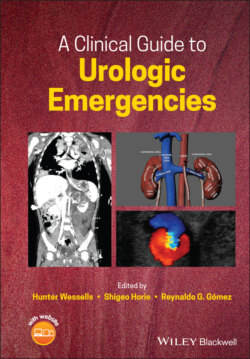Читать книгу A Clinical Guide to Urologic Emergencies - Группа авторов - Страница 20
Indications for Intervention
ОглавлениеAs per AUA guidelines, “the surgical team must perform immediate intervention (surgery or angioembolization in selected situations) in hemodynamically unstable patients with no or transient response to resuscitation” [34]. Intervention is also required in the face of an enlarging or pulsatile perinephric hematoma seen on exploratory laparotomy, suspected renal pedicle avulsion, or a ureteropelvic junction disruption [52]. Depending on the clinical circumstances, these patients may require surgery or angioembolization. Several studies have evaluated high‐risk criteria for bleeding associated with renal trauma, finding that intravascular contrast extravasation, perinephric hematoma of more than 3.5 cm in distance from the parenchymal edge to the hematoma edge, and medial renal laceration are risk factors associated with surgery for hemodynamic instability and the presence of two or more of these risk factors predicts the need for intervention [41–43, 53]. Studies have also evaluated these predictors for angiographic embolization, finding that perirenal hematoma size and intravascular contrast extravasation are indicators for embolization [54]. One study showed that patients without intravascular contrast extravasation and who have a perirenal hematoma rim distance of less than 25 mm are unlikely to benefit from angioembolization, and that combining CT scan‐specific criteria such as intravascular contrast extravasation, perirenal hematoma size, and discontinuity of Gerota's fascia, can be predictive of the need for renal embolization [55]. Intravascular contrast extravasation alone is not an indication for angioembolization or other interventions. It is important to consider the hemodynamic status of the patient and blood transfusion requirements.
Building on these single institution series, the Multi‐institutional Genito‐Urinary Trauma Study Group created a nomogram to predict bleeding interventions after high‐grade renal injury [56]. The variables in the nomogram (Figure 1.3) include mechanism of injury, hemodynamic status, associated injuries, and the following radiographic features: intravascular contrast extravasation; para‐renal hematoma; and hematoma size.
Figure 1.3 Nomogram predicting bleeding interventions after high‐grade renal injury. Points are awarded for “Yes” responses for the first 5 parameters; the Hematoma Rim Distance is scored by tracing a line down to the Points scale in red. Total Points is based on the sum of the first 5 scores and the points from the scale in red. Source: from the MiGUTS Study, with permission [56].
With an area under the ROC (receiver operator characteristic) curve of 0.83, the nomogram performed better than AAST grade alone (which was not included in the nomogram). The nomogram, once externally validated, could provide a means to incorporate imaging data into decision‐making on renal trauma management. Future work will be necessary to determine how to apply the nomogram in clinical care settings. Potential applications include its use to triage patients to ICU (intensive care unit) versus floor care for isolated grade III and IV injuries; ensure appropriateness of transfer from a lower to higher trauma designation hospital; to select treatment of bleeding with embolization versus transfusion alone; and support decisions for operative management [57].
